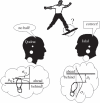What failure in collective decision-making tells us about metacognition
- PMID: 22492752
- PMCID: PMC3318766
- DOI: 10.1098/rstb.2011.0420
What failure in collective decision-making tells us about metacognition
Abstract
Condorcet (1785) proposed that a majority vote drawn from individual, independent and fallible (but not totally uninformed) opinions provides near-perfect accuracy if the number of voters is adequately large. Research in social psychology has since then repeatedly demonstrated that collectives can and do fail more often than expected by Condorcet. Since human collective decisions often follow from exchange of opinions, these failures provide an exquisite opportunity to understand human communication of metacognitive confidence. This question can be addressed by recasting collective decision-making as an information-integration problem similar to multisensory (cross-modal) perception. Previous research in systems neuroscience shows that one brain can integrate information from multiple senses nearly optimally. Inverting the question, we ask: under what conditions can two brains integrate information about one sensory modality optimally? We review recent work that has taken this approach and report discoveries about the quantitative limits of collective perceptual decision-making, and the role of the mode of communication and feedback in collective decision-making. We propose that shared metacognitive confidence conveys the strength of an individual's opinion and its reliability inseparably. We further suggest that a functional role of shared metacognition is to provide substitute signals in situations where outcome is necessary for learning but unavailable or impossible to establish.
Figures








References
-
- Mackay C. 1841. The extraordinary and popular delusions and madness of crowds, 4th edn. Ware, UK: Wordsworth Editions Limited
-
- Condorcet M. 1785. Essai sur l'application de l'analyse á la probabilité des décisions rendues á la pluralité des voix. Paris, France: de l'Impr. Royale
-
- Galton F. 1907. Vox populi. Nature 75, 450–45110.1038/075450a0 (doi:10.1038/075450a0) - DOI - DOI
-
- Kerr N. L., Tindale R. S. 2004. Group performance and decision making. Annu. Rev. Psychol. 55, 623–65510.1146/annurev.psych.55.090902.142009 (doi:10.1146/annurev.psych.55.090902.142009) - DOI - DOI - PubMed
-
- Lorenz J., Rauhut H., Schweitzer F., Helbing D. 2011. How social influence can undermine the wisdom of crowd effect. Proc. Natl Acad. Sci. USA 108, 9020–902510.1073/pnas.1008636108 (doi:10.1073/pnas.1008636108) - DOI - DOI - PMC - PubMed
Publication types
MeSH terms
Grants and funding
LinkOut - more resources
Full Text Sources
